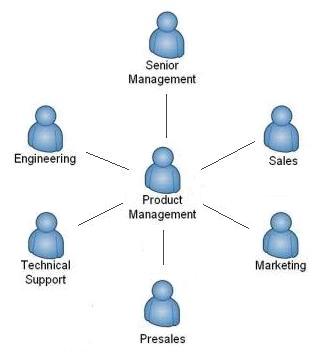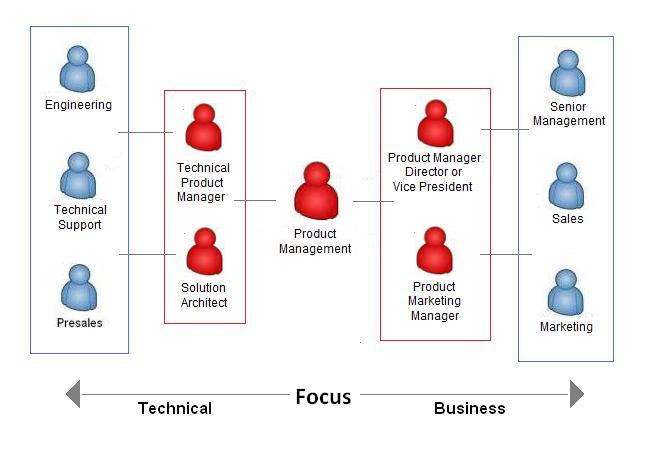Last week I wrote a post entitled How to Create an Effective Product Management Organization. I mentioned that, like other departments such as sales, differentiated roles are needed to support the goals of Product Management, and that I’d cover it in a future post. This is that post. 🙂
Tell me, have you ever seen a job description for a Product Manager that had a long list of duties like this:
- Track and prioritize software feature requests
- Define the business case for complex feature requirements
- Research user needs and expectations for large, complex feature requirements
- Write or oversee the writing of use cases, functional specifications, and test plans for specific feature requirements
- Perform acceptance and ad-hoc functional testing of new features
- Conduct or coordinate usability testing and focus groups
- Monitor and review the progress of software engineering, QA, and documentation
- Coach and mentor junior-level product managers on process or specific requirements
- Help define and influence the long-term product roadmap
- Serve as product expert and resource for sales, marketing, and service teams
I bet you have. Yet another job requiring technical, business, project management, UX, sales, marketing and management skills.
Would the same company ever consider job descriptions for Salespeople that included giving demos, conducting POCs or competitive bake-offs, handling lead generation and nurturing, and post sales support?
Or how about software developers who also could be architects, conduct full QA tests, and write documentation?
Of course not. So why do they think that Product Managers should be responsible for several different roles all wrapped into one?
Personally, I hate these kinds of job descriptions because it’s really clear that the hiring company hasn’t clearly defined the goals of Product Management and thinks that Product Managers are simply Jacks (or Jills) or all trades.
Goals of Product Management
The goals of Product Management are pretty clear – if people think about it.
In short – and I’ll use Don Vendetti’s definition from this post – the goals of Product Management are:
To deliver measurable business results through product solutions that meet both market needs and company goals.
Of course, there are other ways to define this, but this is not a bad definition at all.
Note the focus on business results that align with market needs and company goals. Also note that there is no mention of Agile (or Waterfall or Lean or Extreme etc.) or features or requirements or demos or many of the other things that typically get mentioned when people think about Product Management.
When looking at Don’s definition, the first question that comes to mind is “How?” How is Product Management going to deliver those results?
Take a look at the following diagram. I’m sure you’ve seen diagrams like it before. It’s the hold “hub of the wheel” diagram showing the key internal touchpoints for Product Management.
One of the key activities for any Product Management team is to work with these internal stakeholders to ensure product success. And of course, in cases like the example above, companies expect a single individual to actively and effectively communicate and work with all of these distinct groups while also getting out of the office, working with customers, partners and other parties.
Create Differentiated Roles for Overall Success
And while there are certainly individuals who can do all this, the fact is, it is an impossible task for most people, and leads to both individual and organizational failure. So here’s a simple solution. Understand the needs of these different internal (and external) groups and create differentiated roles WITHIN the Product Management organization and STAFF THEM appropriately. This will help create a scalable effective, and focused Product Management organization.
The following are a few key roles I’ve seen implemented in successful Product Management organizations.
Technical Product Manager
Engineering and Technical Support need more technically focused interaction with Product Management. So define the role of Technical Product Manager (TPM) to work closely with these teams and the issues they raise.
A TPM can act as a Product Owner in an Agile environment, working with a Project Manager (not necessarily part of the PM team) and the Development leads to ensure requirements (user stories etc.) are clear and iterations move forward efficiently. Or, a separate Product Owner role can be defined (whether in the PM org or not) and that role can work with the TPM in an effective manner.
Software Developers or QA staff who want to move into Product Management are great candidates for the TPM role.
Product Marketing Manager
Product Marketing is often a completely separate team from Product Management, reporting into a different executive. e.g. up into the Marketing organization. Everyone says they should work with Product Managers, but they have their own goals and objectives and thus often remain quite separate.
Fundamentally, Product Marketing is strategic marketing for products and is a core component of overall Product Management. Product Marketing should be the primary Product Management interface into the Sales and Marketing organizations. Much of the work remains the same, but it can be done more effectively as part of the Product Management organization.
A good market focused Sales Consultant or Field Marketing person could transition easily into a Product Marketing role.
Solution Architect
For particularly technical or complex products, the role of a solution architect or solution specialist within the Product Management team can be very effective. Product Management is viewed as the “product expert” by external departments, and called upon when thorny issues or new usage scenarios are encountered. But to be effective, even a good TPM needs to have time to focus and understand problems before identifying solutions in sales situations.
Solution Architects are deep product experts with a sales/customer mindset. While this may sound a bit like a Sales Consultant or Sales Engineer (and there is overlap), the goal of these SAs is to work as overlays across prospects and customers, and help the SEs and Technical Support with thorny problems.
The SAs insight can help identify real world product limitations that Product Management should address in the future, or provide clever workarounds to problems that a field SC or Support Engineer couldn’t create.
Technical Sales Consultants, and customer-focused Technical Support Engineers can make great Solution architects.
Product Manager, Director/VP Product Management
And of course, there need to be clear leaders on the team. They can be either people with the title or Product Manager (Senior, Principal etc.) or those at the Director or VP level. Regardless, they must be seasoned veterans, who’ve been down in the trenches and understand the details, but now focus on managing and developing the team, strategy, and cross-organizational and external alignment. And while much of the interaction between Product Management and the Executive team will here, these leaders need to ensure the individual contributors they manage get executive face time when needed.
Other roles
Depending on the company, it’s structure and needs, other roles such as Interaction Designer, Business Analyst and even Project Manager could be part of the Product Management organization. These are less common in my experience and thus not addressed in this post.
Organizing for Efficiency, Scalability and Success
Once the various roles have been defined, their objectives and responsibilities set, a diagram showing how they interact across internal teams could look like:
This is clearly a simplified diagram. I know some people may take it more literally than intended or object to how the roles are laid out or connected.
So just to be clear, the lines connecting the different roles show the PRIMARY areas of focus for the roles. e.g. The Product Manager/Director/VP doesn’t ignore Engineering, Technical Support or Presales, but is more focused on the BUSINESS aspects of the product and thus engages more actively with Senior Management, Sales and Marketing, though not in the same way as the Product Marketing Manager. Each has their own objectives and goals, but work across similar teams.
It’s also clear that the cross functional nature of Product Management poses a challenge for many organizations. What is the best way to set up responsibilities and roles? How should they be staffed? When should the new roles be created in an organization.
All good questions. There is no clear answer, and that’s why it’s incredibly important to have experienced leadership running the organization.
Saeed
Tweet this: @onpm New post – The Importance of Differentiated #prodmgmt Roles http://wp.me/pXBON-2hF #prodmktg #leadership

